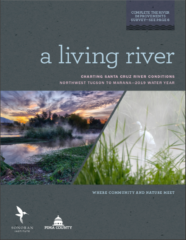Charting Santa Cruz River Conditions from Northwest Tucson to Marana – 2019 Water Year
The Santa Cruz River near El Camino Del Cerro and flowing north into Marana, has been improving for almost a decade, and important milestones and improvements are cause for much celebration. The newly released Pima County and Sonoran Institute Living River report for the 2019 Water Year will help to serve as a reminder of previous river conditions and highlights improvements made since 2013. Lower ammonia levels, a shorter flow extent, and a diverse community of aquatic invertebrates shows a positive trend of upgraded river health that project managers indicate will lead to enhanced opportunities along the river corridor. The new report also invites the public to participate in an on-line survey to provide feedback on proposed projects for further improvements.

“This Living River report gives new, vivid detail on how the Santa Cruz River continues to improve as a result of technological advances and input from cyclists, birdwatchers, educators, and outdoor enthusiasts. Now with sections of the Santa Cruz River in Tucson flowing downtown and all the way up through Marana, there are even more opportunities to get out and appreciate this rare desert river,” said Luke Cole, Associate Director at Sonoran Institute.
The river flows year-round and is a direct result of the effluent discharge from the Pima County Wastewater Reclamation Facilities located along the river’s corridor. After wastewater treatment upgrades in 2013, there was a noticeable reduction in the amounts of ammonia, a form of nitrogen common in effluent and toxic to fish and aquatic invertebrates at high concentrations. Through an improved process to remove ammonia from wastewater, greater aquatic diversity has now been monitored and observed in the river.
Since water treatment upgrades came online in 2013, nearly 5 times the number of aquatic invertebrates now call the river home. The aquatic invertebrate community may be stabilizing as no new species were found in 2019 surveys.
While allowing aquatic life to thrive, cleaner effluent discharged into the river can also infiltrate more quickly into the aquifer system. This means that more water goes underground instead of flowing at the surface, resulting in a shorter flow extent.
The improved conditions also have drawn more people to the river, which has led Pima County to work more closely with residents by requesting and receiving feedback on how community members want to see the river managed.
“We want to hear what residents and river users have to say about a variety of projects that could be implemented and would be beneficial along the river, and are asking the public to participate in an on-line survey. We are developing a Santa Cruz River Management Plan and strategy to balance flood risk management, drainage infrastructure protection, water resources, recreation, education opportunities and riparian habitat preservation,” said Evan Canfield of the Pima County Regional Flood Control District.
The Living River reports are a joint effort between Pima County and Sonoran Institute, and the latest report is the seventh in an annual series. The report is available at https://sonoraninstitute.org/resource/living-river-report-2019
For More Information and Getting Involved?
- Pima County is asking you to join the conversation by taking a survey to learn about the potential projects along the Santa Cruz River. Tell us what you think and have your voice heard! Complete the survey by December 31, 2020 at tiny.cc/scrprojects
- Follow Pima County’s progress on the Santa Cruz River Management Plan at pima.gov/santacruzriverplan
- Celebrate the river and join a virtual Dragonfly Day on the Santa Cruz– October 3, 2020 9:00 a.m. to 11:30 a.m. https://sonoraninstitute.org/events/dragonfly20/
Contact
Corinne Matesich, Marketing Communications Manager, (520) 290-0828 x 1105, cmatesich@sonoraninstitute.org
